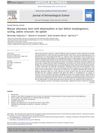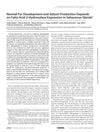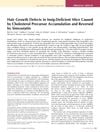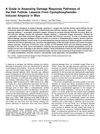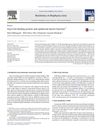Ceramide Synthase 4 Deficiency in Mice Causes Lipid Alterations in Sebum and Results in Alopecia
April 2014
in “
Biochemical Journal
”
TLDR Ceramide synthase 4 deficiency in mice leads to hair loss due to altered sebum lipids.
The study investigated the role of ceramide synthase 4 (CerS4) in mice by generating CerS4-deficient mice (Cers4−/−) and analyzing the effects on lipid composition in sebum. The absence of CerS4 led to altered lipid composition, resulting in more solidified sebum, which potentially caused progressive hair loss by physically blocking the hair canal. Additionally, there was a significant decrease in C20 1,2-alkane diols and wax diesters in the sebum of Cers4−/− mice. By 12 months, these mice exhibited further epidermal tissue destruction due to dilated and obstructed pilary canals. Mass spectrometric analyses revealed a strong decrease in C20-containing sphingolipids, highlighting the critical role of CerS4 in maintaining normal lipid composition and preventing alopecia.
